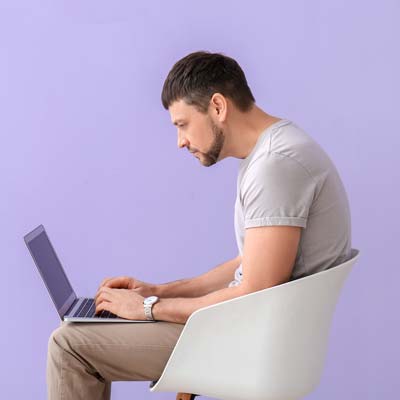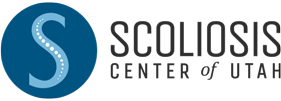Blogs
Can poor posture be caused by scoliosis?

Are you suffering from forward head posture, slumped shoulders or a swayed or flat back? When the body has optimal posture, everything is aligned from head to foot. This means that your head rests over your shoulders, your shoulders over your hips, and your hips over your knees—all without straining, forcing, or “standing up straight.”
While it is commonly believed that good posture can be “forced” with the help of will-power and regular reminders, the truth is, it’s not that simple. Poor posture can be caused by a variety of complex factors, one of the most common of which is scoliosis. If you’ve been asking “can poor posture be caused by scoliosis?” here’s everything you need to know:
What is scoliosis?
Scoliosis is a condition that causes the spine to curve from side to side. If you viewed someone with scoliosis from behind, their spine would have a curve that looks like a C or an S. Scoliosis commonly begins in childhood, the exact cause differing from individual to individual.
Left untreated, the curvature in the spine can worsen, causing whatever side effects and symptoms someone may be experiencing to worsen.
#1. Scoliosis can affect the neck.
Although the scoliosis curve that occurs in the spine typically occurs in the back region, and does not directly create a curve in the neck, scoliosis can still affect the neck. This is because the entire spine must be aligned in order to create good posture. If the spine is not properly aligned in one area, it will cause tension in the neck, sometimes resulting in pain, poor neck posture, and in some cases, numbness and tingling may result.
#2. Scoliosis can strain the shoulders.
Just like with the neck, when the spine is out of alignment at any point, it can create tension and misalignment in other parts of the body as they struggle to compensate. When scoliosis is present, this can compromise the strength of muscles, bones, and joints in various areas of the back, making it difficult to maintain good posture. When this happens, it can become very difficult to stand or sit upright, leading to roundedness in the shoulders, as well as tension in the joints, ligaments, and tendons.
#3. Scoliosis can cause pain in the back.
When the spine is curved and misaligned, this can create “subluxations” in the spine. Subluxations are areas where the joints have moved out of place in the spine, making nearby nerves painful and inflamed. This results in back pain that can feel like aching, sharp pain, like numbness, tingling, or shooting pain, or simply like weakness and light discomfort.
#4. Scoliosis can cause the body to compensate in unexpected ways.
The body is always trying to return to homeostasis, and when it comes to the structure of the spine, upright and aligned posture is a critical part of the skeletal system’s role. If upright and aligned posture is not available from the spine, the body will compensate in other ways to try to achieve it.
For individuals with scoliosis, this often means that the head, neck, jaw, hips, shoulders, and knees become strained from trying to support or work with the misaligned spine.
#5. Scoliosis can contribute to poor posture.
When the spine is in a C or S shaped curve, it is impossible to have upright posture unless this is corrected. While for some people, poor posture may simply be the result of poor postural habits, for those with scoliosis, their condition makes it physically impossible for them to have ideal posture.
#6. Scoliosis can cause arthritis in the spinal joints.
If left untreated, scoliosis can cause the discs and joints of the spine to degenerate, which can lead to arthritis.
#7. Scoliosis can cause spinal stenosis.
Over time, scoliosis can wear away at the spine, placing pressure in areas of the spine that shouldn’t be in contact. This can degenerate the area and cause a narrowing of the spinal exterior.
#8. Scoliosis can be treated non-surgically.
While one of the most common treatment recommendations for severe scoliosis is surgery, there are options available to treat scoliosis that do not include invasive interventions. Scoliosis surgery comes in many forms, including laminectomy, microdiscectomy, spinal fusion, osteotomy, and vertebral column resection.
Some forms of surgery are more intensive than others: for example, spinal fusion is the permanent joining of bones together through grafting, while a microdiscectomy is the surgical release of pressure from nerves.
Options for non-surgical scoliosis treatment include spinal traction and bracing, both of which have shown to be highly effective in helping individuals correct their scoliosis symptoms long-term.
Seeking treatment for scoliosis.
If you or a loved one have been diagnosed with scoliosis and are seeking treatment, it’s time to visit Scoliosis Center of Utah. Clinical director Dr. Katalina Dean, often referred to as the best scoliosis doctor in Salt Lake City, Utah, has devoted a large portion of her professional career to treating scoliosis.
At Scoliosis Center of Utah, Dr. Dean has employed two forms of treatment that have proved highly successful for countless patients. These two treatments are spinal traction using the Chiropractic BioPhysics® techniques, and bracing using ScoliBrace®.
Chiropractic BioPhysics® (CBP) is a form of chiropractic care used by the best scoliosis chiropractors in Midvale, UT. CBP uses mirror image adjustments and customized spinal traction setups to create tangible, long-lasting results in the shape of the spine.
Additionally, Scoliosis Center of Utah offers ScoliBrace®, a unique customized treatment for individuals of all ages. The ScoliBrace® is a non-surgical solution to scoliosis that, like orthodontia, helps to move bones and joints back into proper alignment over time.
If you’re ready to experience the best scoliosis treatment in Salt Lake City, UT, look no further—Scoliosis Center of Utah is prepared to provide the most cutting-edge, non-invasive scoliosis treatment available. To begin improving your posture, mobility, and pain, as well as your future health outcomes, contact us today.
Do You Qualify for Care?
Schedule an Appointment Below
